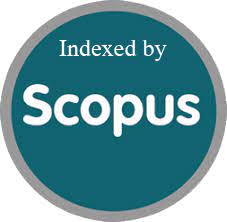Muscle-sparing posterolateral thoracotomy for esophageal atresia Vogt Type 3b
DOI:
https://doi.org/10.52783/jns.v11.1074Keywords:
Esophageal atresia, Muscle-sparing, Posterolateral, Skin crease, ThoracotomyAbstract
Background: Posterolateral muscle cutting thoracotomy is the gold standard approach to repair esophageal atresia with distal tracheoesophageal fistula. This technique is associated with morbidities in terms of poor motor and aesthetic outcomes. We aim to share our experience with muscle-sparing skin crease incision posterolateral thoracotomy for esophageal atresia Vogt type 3b.
Methods: It was a retrospective observational study conducted over a period of 3 years and 6 months from January 2016 to June 2019 at two tertiary care teaching institutes. All patients with esophageal atresia having distal tracheoesophageal fistula were included.
Results: Fifty-nine neonates underwent muscle-sparing thoracotomy, with 23 males and 36 females. The 34 (58%) neonates had low birth weight. Anorectal malformation (ARM) was the most common (6) associated major malformation(18). Intraoperative findings included long gap EA (6), right aortic arch (RAA, 3), aberrant vessels (1), and long upper pouch (1). Conversion to muscle cutting approach (during early learning curve) was performed in 8 cases i.e. long gap EA (3), RAA (2), Subglottic stenosis (2), others (1). No intraoperative complication was encountered; postoperative seroma formation (related to the approach) was observed in 2 (3.4%) neonates. Most of the patients achieved satisfactory functional and aesthetic outcomes.
Conclusions: Muscle-sparing skin crease incision posterolateral thoracotomy is a viable approach for repair of esophageal atresia with distal tracheoesophageal fistula. The technique is easy to perform with adequate exposure and provides satisfactory functional and aesthetic outcomes with relatively minimum morbidity.
Downloads
Metrics
References
Taguchi T, Nagata K, Kinoshita Y, Ieiri S, Tajiri T, Teshiba R, et al. The utility of muscle sparing axillary skin crease incision for pediatric thoracic surgery. Pediatr Surg Int. 2012; 28:239-44.
Bianchi A, Sowande O, Alizai NK, Rampersad B. Aesthetics and lateral thoracotomy in the neonate. J Pediatr Surg. 1998; 33:1798-1800.
Kalman A, Verebely T. The use of axillary skin crease incision for thoracotomies of neonates and children. Eur J Pediatr Surg. 2002; 12:226-9.
Spitz L. Oesophageal atresia. Orphanet J Rare Dis. 2007; 2:24.
Bairdain S, Zurakowski D, Vargas SO, Stenquist N, McDonald M, Towne MC, et al. Long-gap esophageal atresia is a unique entity within the esophageal atresia defect spectrum. Neonatology. 2017; 111:140-4.
Gupta R, Sharma P, Goyal RB. Kluth Type IIIb6 Esophageal atresia: diagnostic dilemma and pitfalls of using infant feeding tube. J Indian Assoc Pediatr Surg. 2018; 23:96-9.
Mortell AE. Azizkhan RG. Esophageal atresia repair with thoracotomy: the Cincinnati contemporary experience. Semin Pediatr Surg. 2009; 18:12-9.
Uzzaman MM, Robb JD, Mhandu PC, Khan H, Baig K, Chaubey S, et al. A meta-analysis comparing muscle-sparing and posterolateral thoracotomy. Ann Thorac Surg. 2014; 97:1093-102.
Hazelrigg SR, Landreneau RJ, Boley TM, Priestmeyer ML, Schmaltz RA, Nawarawong W, et al. The effect of muscle sparing versus standard posterolateral thoracotomy on pulmonary function, muscle strength, and postoperative pain. J Thorac Cardiovasc Surg. 1991; 101:394-400.
Athanassiadi K, Kakaris S, Theakos N, Skottis I. Muscle-sparing versus posterolateral thoracotomy: A prospective study. Eur J Cardiothorac Surg. 2007; 31:496-9.
Singh SJ, Kapila L. Denis Browne’s thoracotomy revised. Pediatr Surg Int. 2002; 18:90-2.
Noirclerc M, Dor V, Chauvin G, Kreitman P, Masselot R, Balenbois D, et al. Extensive lateral thoracotomy without muscle section. Ann Chir Thorac Cardiovasc. 1973; 12:181-4.
Mitchell R, Angell W, Wuerflein R, Dor V. Simplified lateral chest incision for most thoracotomies other than sternotomy. Ann Thorac Surg. 1976; 22:284-6.
Bethencourt DM, Holmes EC. Muscle-sparing posterolateral thoracotomy. Ann Thorac Surg. 1988; 45:337-9.
Landreneau RJ, Pigula F, Luketich JD, KeenanRJ, Bartley S, Fetterman LS, et al. Acute and chronic morbidity differences between muscle-sparing and standard lateral thoracotomies. J Thorac Cardiovasc Surg. 1996; 112:1346-50.
Akcali Y, Demir H, Tezcan B. The effect of standard posterolateral versus muscle-sparing thoracotomy on multiple parameters. Ann Thorac Surg. 2003; 6:1050-4.
Saiad MO. The modified posterior thoracotomy for esophageal atresia. J Indian Assoc Pediatr Surg. 2017; 22:217-9.
Ashour M. Modified muscle sparing posterolateral thoracotomy. Thorax. 1990; 45:935-8.
Ziyade S, Baskent A, Tanju S, Toker A, Dilege S. Isokinetic muscle strength after thoracotomy: Standard vs. muscle-sparing posterolateral thoracotomy. Thorac Cardiovasc Surg. 2010; 58:295-8.
Sugi K, Nawata S, Kaneda Y, Nawata K, Ueda K, Esato K. Disadvantages of muscle-sparing thoracotomy in patients with lung cancer. World J Surg. 1996; 20:551-5.
Ponn RB, Ferneini A, D’Agostino RS, Toole AL, Stern H. Comparison of late pulmonary function after posterolateral and muscle-sparing thoracotomy. Ann Thorac Surg. 1992; 53:675-9.
Elswick SM, Blackmon SH, Sharaf B. Muscle-sparing thoracotomy. Oper Tech Thorac Cardiovasc Surg. 2017; 22:110-21.
Gupta R. Esophageal atresia: Early outcome analysis from a high-volume tertiary care institute in India. Saudi J Health Sci. 2018; 7:14-22.

Published
How to Cite
Issue
Section
License
Copyright (c) 2022 Rahul Gupta

This work is licensed under a Creative Commons Attribution 4.0 International License.
You are free to:
- Share — copy and redistribute the material in any medium or format
- Adapt — remix, transform, and build upon the material for any purpose, even commercially.
Terms:
- Attribution — You must give appropriate credit, provide a link to the license, and indicate if changes were made. You may do so in any reasonable manner, but not in any way that suggests the licensor endorses you or your use.
- No additional restrictions — You may not apply legal terms or technological measures that legally restrict others from doing anything the license permits.










